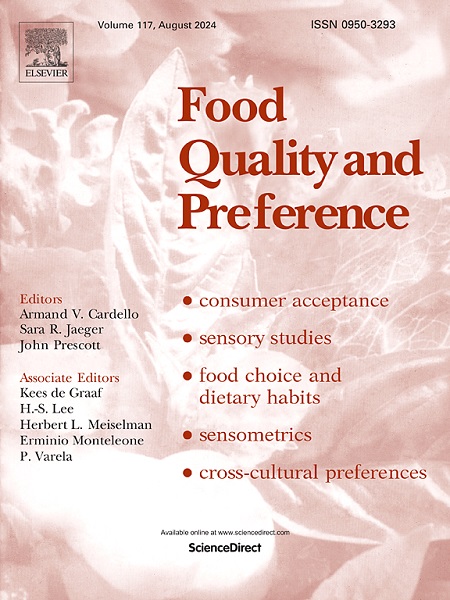The eyes eat first: Improving consumer acceptance of plant-based meat alternatives by adjusting front-of-pack labeling
IF 4.9
1区 农林科学
Q1 FOOD SCIENCE & TECHNOLOGY
引用次数: 0
Abstract
The substitution of meat products with plant-based meat (PBM) alternatives is seen to foster sustainable consumption. It can play an important role in helping reach greenhouse gas emission targets. While consumers generally perceive PBM alternatives as more environmentally friendly and healthier than meat, they often find them less hedonically appealing and too expensive, which hinders their widespread adoption. One effective strategy to encourage consumers toward more sustainable choices is the use of front-of-pack information, such as claims and labels. This study identifies the most effective labeling strategy to increase consumers' preference for PBM burger patties through a three-fold research approach, namely, a supermarket audit in the UK, a best-worst scaling study (i.e., Maximum Difference Scaling), and a discrete choice experiment (i.e., choice-based conjoint analysis). In the UK market, front-of-pack labels and claims presented on PBM products can be categorized into those primarily related to nutrition, ecological welfare, and taste. These categories correspond to three distinct consumer segments extracted from a best-worst scaling study. A subsequent discrete choice experiment, which compared labeled PBM patties vis-à-vis meat patties, revealed that a third-party accredited taste label has the potential to gain the highest market share and willingness-to-pay among all types of labels/claims. Our findings underscore the importance of adopting an appropriate labeling strategy to foster sustainable food consumption.
眼睛先吃:通过调整包装正面标签,提高消费者对植物性肉类替代品的接受度
用植物性肉类(PBM)替代品替代肉类产品被视为促进可持续消费。它可以在帮助实现温室气体排放目标方面发挥重要作用。虽然消费者普遍认为PBM替代品比肉类更环保、更健康,但他们往往觉得PBM替代品不那么吸引人,而且价格太贵,这阻碍了PBM替代品的广泛采用。鼓励消费者做出更可持续选择的一个有效策略是使用包装正面信息,如声明和标签。本研究通过三重研究方法确定了最有效的标签策略,以增加消费者对PBM汉堡肉饼的偏好,即英国的超市审计,最佳最差缩放研究(即,最大差异缩放)和离散选择实验(即,基于选择的联合分析)。在英国市场,PBM产品的包装前标签和声明可以分为主要与营养、生态福利和味道有关的标签和声明。这些类别对应于从最佳-最差尺度研究中提取的三个不同的消费者群体。随后的离散选择实验,比较了贴有标签的PBM肉饼和-à-vis肉饼,发现第三方认可的味道标签有可能在所有类型的标签/声明中获得最高的市场份额和支付意愿。我们的研究结果强调了采用适当的标签策略以促进可持续食品消费的重要性。
本文章由计算机程序翻译,如有差异,请以英文原文为准。
求助全文
约1分钟内获得全文
求助全文
来源期刊

Food Quality and Preference
工程技术-食品科技
CiteScore
10.40
自引率
15.10%
发文量
263
审稿时长
38 days
期刊介绍:
Food Quality and Preference is a journal devoted to sensory, consumer and behavioural research in food and non-food products. It publishes original research, critical reviews, and short communications in sensory and consumer science, and sensometrics. In addition, the journal publishes special invited issues on important timely topics and from relevant conferences. These are aimed at bridging the gap between research and application, bringing together authors and readers in consumer and market research, sensory science, sensometrics and sensory evaluation, nutrition and food choice, as well as food research, product development and sensory quality assurance. Submissions to Food Quality and Preference are limited to papers that include some form of human measurement; papers that are limited to physical/chemical measures or the routine application of sensory, consumer or econometric analysis will not be considered unless they specifically make a novel scientific contribution in line with the journal''s coverage as outlined below.
 求助内容:
求助内容: 应助结果提醒方式:
应助结果提醒方式:


